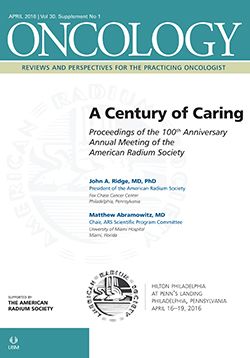(S020) The Role of Adjuvant Radiotherapy in T4 Colon Cancer
In this large population dataset, adjuvant radiation was associated with an improvement in OS in a modern cohort of patients. Patients with distal tumors, higher-grade disease, negative lymph nodes, and larger tumors may derive a greater benefit with radiation.
Talha Shaikh, MD, Thomas M. Churilla, MD, Colin T. Murphy, MD, Michael Hall, MD, MS, Elin R. Sigurdson, MD, PhD, Joshua E. Meyer, MD; Fox Chase Cancer Center
BACKGROUND: The role of adjuvant radiation for T4 colon adenocarcinoma is controversial. We assessed the impact of adjuvant radiation on treatment outcomes in a large national dataset.
MATERIALS AND METHODS: The Surveillance, Epidemiology, and End Results (SEER) registry was queried from 1988–2012 for patients aged > 18 years diagnosed with T4 colon adenocarcinoma who underwent curative surgery. The primary endpoints were overall survival (OS) and cancer-specific survival (CSS) for patients treated with or without adjuvant radiation. Survival was assessed utilizing the Kaplan-Meier method and a Cox proportional hazards model.
RESULTS: A total of 29,830 patients were identified; 1,877 (6.3%) patients received adjuvant radiation. There was no difference in OS (P = .384) with adjuvant radiation. Patients receiving radiation had a worse CSS than patients who received no adjuvant radiation (P < .001). On examination of a modern cohort of patients treated from 2004–2012, patients receiving adjuvant radiation had an improvement in OS compared with patients receiving no radiation (P < .001), and there was a trend toward improved CSS in patients receiving adjuvant radiation (P = .053). On multivariable analysis, adjuvant radiation remained associated with OS (hazard ratio [HR], 0.88 [95% CI, 0.78–0.99]; P = .034). Subgroup analysis demonstrated an OS benefit with radiation in patients with distal tumors (P = .002), grade 3/4 disease (P = .006), grade 2 disease (P = .012), negative lymph nodes (P < .001), and tumor size > 5 cm (P < .001).
CONCLUSION: In this large population dataset, adjuvant radiation was associated with an improvement in OS in a modern cohort of patients. Patients with distal tumors, higher-grade disease, negative lymph nodes, and larger tumors may derive a greater benefit with radiation.
Proceedings of the 98th Annual Meeting of the American Radium Society - americanradiumsociety.org

Targeted Therapy First Strategy Reduces Need for Chemotherapy in Newly Diagnosed LBCL
December 7th 2025Lenalidomide, tafasitamab, rituximab, and acalabrutinib alone may allow 57% of patients with newly diagnosed LBCL to receive less than the standard number of chemotherapy cycles without compromising curative potential.